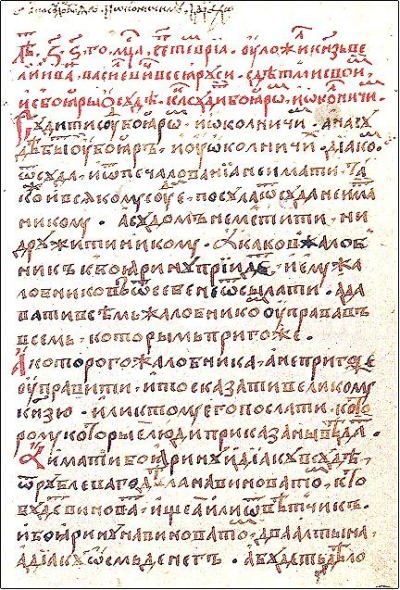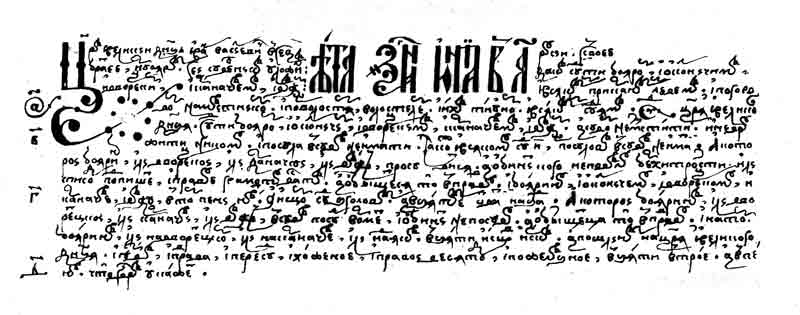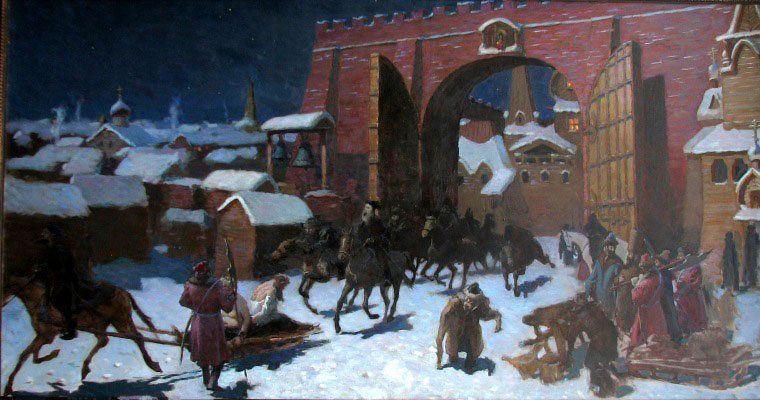|
Forbidden Years
Forbidden Years () were part of a tightening of the service obligations of serfs in Russia leading to full-scale serfdom in the seventeenth through nineteenth centuries. They were first instituted by Tsar Ivan IV (r. 1533–1584) in 1581 as a temporary measure, but eventually became permanent. Under the provisions of Article 57 of the Sudebnik of 1497 promulgated by Grand Prince Ivan III, serfs were permitted to transfer from one estate to another "once a year, during the week before and a week after St. George's Day in the autumn" (November 26, the Feast of the Dedication of the Church of St. George in Kiev) provided they had fulfilled all corvée (''barshchina'', барщина in Russian) and/or quitrent (''obrok'', оброк in Russian) obligations and had paid a fee, the ''pozhiloe'' (пожилое), to the landlord they were leaving. In Ivan IV's Sudebnik of 1550, this right of transfer remained (Article 88), but the ''pozhiloe'' was increased and a tax (the transition f ... [...More Info...] [...Related Items...] OR: [Wikipedia] [Google] [Baidu] |
Tsar Ivan IV
Ivan IV Vasilyevich (russian: Ива́н Васи́льевич; 25 August 1530 – ), commonly known in English as Ivan the Terrible, was the grand prince of Moscow from 1533 to 1547 and the first Tsar of all Russia from 1547 to 1584. Ivan was the son of Vasili III, the Rurikid ruler of the Grand Duchy of Moscow. He was appointed grand prince after his father's death, when he was three years old. A group of reformers known as the "Chosen Council" united around the young Ivan, declaring him tsar (emperor) of all Rus' in 1547 at the age of 16 and establishing the Tsardom of Russia with Moscow as the predominant state. Ivan's reign was characterised by Russia's transformation from a medieval state to an empire under the tsar but at an immense cost to its people and its broader, long-term economy. During his youth, he conquered the khanates of Kazan and Astrakhan. After he had consolidated his power, Ivan rid himself of the advisers from the "Chosen Council" and triggered the ... [...More Info...] [...Related Items...] OR: [Wikipedia] [Google] [Baidu] |
Sudebnik Of 1497
The Sudebnik of 1497 (''Судебник 1497 года'' in Russian, or Code of Law) was a collection of laws introduced by Ivan III in 1497. It played a big part in the centralisation of the Russian state, creation of the nationwide Russian Law and elimination of feudal fragmentation.Monuments of Russian Law. Vol. 3: Monuments of Law in the Period of Formation of Russian Centralized State in 14—15 centuries / ed. by Lev Cherepnin. Moscow, 1955. P. 419—420, 426—432, 438—457. (russianПамятники русского права. М.: Госюриздат, 1955. Вып. 3: Памятники права периода образования Русского централизованного государства XIV—XV вв./ под ред. Л.В. Черепнина. С. 341—416. Also full Old Russian text and translation into modern Russian). It took its roots from Old Russian Law, including Russkaya Pravda, Legal Code of Pskov, princely decrees, and common law, the ... [...More Info...] [...Related Items...] OR: [Wikipedia] [Google] [Baidu] |
Ivan III
Ivan III Vasilyevich (russian: Иван III Васильевич; 22 January 1440 – 27 October 1505), also known as Ivan the Great, was a Grand Prince of Moscow and Grand Prince of all Rus'. Ivan served as the co-ruler and regent for his blind father Vasily II from the mid-1450s before he officially ascended the throne in 1462. He multiplied the territory of his state through war and through the seizure of lands from his dynastic relatives, ended the dominance of the Tatars over Russia, renovated the Moscow Kremlin, introduced a new legal codex and laid the foundations of the Russian state. His 1480 victory over the Great Horde is cited as the restoration of Russian independence, 240 years after the fall of Kiev in the Mongol invasion of Kievan Rus'. Ivan was the first Russian ruler to style himself "tsar", albeit not as an official title. Through marriage to Sofia Paleologue, he made the double-headed eagle Russia's coat of arms and adopted the idea of Moscow as Third Rom ... [...More Info...] [...Related Items...] OR: [Wikipedia] [Google] [Baidu] |
Corvée
Corvée () is a form of unpaid, forced labour, that is intermittent in nature lasting for limited periods of time: typically for only a certain number of days' work each year. Statute labour is a corvée imposed by a state for the purposes of public works. As such it represents a form of levy (taxation). Unlike other forms of levy, such as a tithe, a corvée does not require the population to have land, crops or cash. The obligation for tenant farmers to perform corvée work for landlords on private landed estates was widespread throughout history before the Industrial Revolution. The term is most typically used in reference to medieval and early modern Europe, where work was often expected by a feudal landowner (of their vassals), or by a monarch of their subjects. The application of the term is not limited to that time or place; the corvée has existed in modern and ancient Egypt, ancient Sumer, ancient Rome, China, Japan, everywhere in continental Europe, the Incan civi ... [...More Info...] [...Related Items...] OR: [Wikipedia] [Google] [Baidu] |
Quitrent
Quit rent, quit-rent, or quitrent is a tax or land tax imposed on occupants of freehold or leased land in lieu of services to a higher landowning authority, usually a government or its assigns. Under feudal law, the payment of quit rent (Latin ''Quietus Redditus'', pl. ''Redditus Quieti'') freed the tenant of a holding from the obligation to perform such other services as were obligatory under feudal tenure, or freed the occupier of the land from the burden of having others use their own distinct rights that affected the land (e.g. hunting rights which would have hindered farming). Thus it was a payment for distinct rights that were connected with the full enjoyment of the land but not parcelled up in the ownership of the land. Formally it was a sort of buy-back rather than a tax. A tax can be varied by the taxer; and if not paid there are penalties that can be varied by the taxer without formal limit. In contrast the only sanction for not paying a feudal quit rent was that the ... [...More Info...] [...Related Items...] OR: [Wikipedia] [Google] [Baidu] |
Sudebnik Of 1550
Sudebnik of Tsar Ivan IV (russian: Судебник) was an expansion and revision of the Sudebnik of 1497, a code of laws instituted by Ivan the Great, his grandfather. It is considered the result of the first Russian parliament of feudal Estates (Zemsky Sobor The Zemsky Sobor ( rus, зе́мский собо́р, p=ˈzʲemskʲɪj sɐˈbor, t=assembly of the land) was a parliament of the Tsardom of Russia's estates of the realm active during the 16th and 17th centuries. The assembly represented Russi ...). The Sudebnik of 1550 liquidated the aristocracy's judicial privileges and strengthened the role of state judicial bodies. The Sudebnik also provided for the active participation of the elective representatives of local communities (rural heads, jurymen, ''tselovalniki'', ''dvorskie'' etc.) in legal proceedings. The arrest of suspects could be made only at the consent of the local community. The representative of a community (''dyak'') participated in judicial office-wor ... [...More Info...] [...Related Items...] OR: [Wikipedia] [Google] [Baidu] |
Livonian War
The Livonian War (1558–1583) was the Russian invasion of Old Livonia, and the prolonged series of military conflicts that followed, in which Tsar Ivan the Terrible of Russia (Muscovy) unsuccessfully fought for control of the region (present-day Estonia and Latvia). The Tsardom of Russia (Muscovy) faced a varying coalition of the Dano-Norwegian Realm, the Kingdom of Sweden, and the Union (later Commonwealth) of the Grand Duchy of Lithuania and the Kingdom of Poland. From 1558 to 1578, Russia controlled the greater part of the region with early military successes at Dorpat (Tartu) and Narwa (Narva). The dissolution of the Livonian Confederation brought Poland–Lithuania into the conflict, and Sweden and Denmark intervened between 1559 and 1561. Swedish Estonia was established despite continuing attacks from Russia, and Frederick II of Denmark bought the old Bishopric of Ösel–Wiek, which he placed under the control of his brother Magnus of Holstein. Magnus attemp ... [...More Info...] [...Related Items...] OR: [Wikipedia] [Google] [Baidu] |
Oprichnina
The oprichnina (russian: опри́чнина, ) was a state policy implemented by Tsar Ivan the Terrible in Russia between 1565 and 1572. The policy included mass repression of the boyars (Russian aristocrats), including public executions and confiscation of their land and property. In this context it can also refer to: *The notorious organization of six thousand Oprichniki, the first political police in the history of Russia. *The portion of Russia, ruled directly by Ivan the Terrible, where his Oprichniki operated. *The corresponding period of Russian history. The term ''oprichnina'', which Ivan coined for this policy, derives from the Russian word ''oprich'' (russian: опричь, ''apart from'', ''except''). Causes In 1558, Tsar Ivan IV started the Livonian War. A broad coalition, which included Poland, Lithuania and Sweden, became drawn into the war against Russia. The war became drawn-out (it continued until 1583) and expensive; raids by Crimean Tatars, Polish and Li ... [...More Info...] [...Related Items...] OR: [Wikipedia] [Google] [Baidu] |
Statute Of Limitations
A statute of limitations, known in civil law systems as a prescriptive period, is a law passed by a legislative body to set the maximum time after an event within which legal proceedings may be initiated. ("Time for commencing proceedings") In most jurisdictions, such periods exist for both criminal law and civil law such as contract law and property law, though often under different names and with varying details. When the time which is specified in a statute of limitations runs out, a claim might no longer be filed or, if it is filed, it may be subject to dismissal if the defense against that claim is raised that the claim is time-barred as having been filed after the statutory limitations period. When a statute of limitations expires in a criminal case, the courts no longer have jurisdiction. Most common crimes that have statutes of limitations are distinguished from particularly serious crimes because the latter claims may be brought at any time. In civil law systems, such ... [...More Info...] [...Related Items...] OR: [Wikipedia] [Google] [Baidu] |
Fixed Years
Fixed years () was the term used in Russian documents for the statute of limitations during which a run-away serf could be sought out and returned to his landlord. They were fixed at five years by an ukaz (decree) of Tsar Fedor Ivanovich issued on November 24, 1597. They were done away with as part of the Ulozhenie of 1649, where there was no limit on the time a serf could be sought out and returned to his estate.See Chapter Eight of Ruslan Skrynikov's Boris Godunov: Zapovednye i urochnye rody Tsara Fedora Ioanovicha." (Moscow: Nauka, 1978). See also *George's Day in Autumn George's Day in Autumn, or Saint George's Day (russian: Егорий Осенний, Yegoriy Osenniy, George's Day in Autumn, or russian: Юрьев день, Yuriev den, George's Day; sr, / ) is one of two feasts of Saint George, celebrat ... References {{Reflist Serfdom * ... [...More Info...] [...Related Items...] OR: [Wikipedia] [Google] [Baidu] |
Sobornoye Ulozheniye
The Sobornoe Ulozhenie ( rus, Соборное уложение, p=sɐˈbornəjə ʊlɐˈʐɛnʲɪjə, t=Council Code) was a legal code promulgated in 1649 by the Zemsky Sobor under Alexis of Russia as a replacement for the Sudebnik of 1550 introduced by Ivan IV of Russia. The code survived well into the 19th century (up to 1832), when its articles were revised under the direction of Mikhail Speransky. The code consolidated Russia's slaves and free peasants into a new serf class and pronounced class hereditary as unchangeable (see Russian serfdom). The new code prohibited travel between towns without an internal passport. Russian nobility agreed to serve in the army, but were granted the exclusive privilege of owning serfs. The law code conceded many demands that were raised in the preceding decades, it satisfied the nobility's demand to retrieve runaway serfs without a time-limit, and which allowed the 'serf bondage to the soil' to later evolve into a far more comprehensive serf ... [...More Info...] [...Related Items...] OR: [Wikipedia] [Google] [Baidu] |
Russian Serfs
Russian(s) refers to anything related to Russia, including: *Russians (, ''russkiye''), an ethnic group of the East Slavic peoples, primarily living in Russia and neighboring countries *Rossiyane (), Russian language term for all citizens and people of Russia, regardless of ethnicity *Russophone, Russian-speaking person (, ''russkogovoryashchy'', ''russkoyazychny'') *Russian language, the most widely spoken of the Slavic languages *Russian alphabet *Russian cuisine *Russian culture *Russian studies Russian may also refer to: *Russian dressing *''The Russians'', a book by Hedrick Smith *Russian (comics), fictional Marvel Comics supervillain from ''The Punisher'' series *Russian (solitaire), a card game * "Russians" (song), from the album ''The Dream of the Blue Turtles'' by Sting *"Russian", from the album ''Tubular Bells 2003'' by Mike Oldfield *"Russian", from the album '' '' by Caravan Palace *Nik Russian, the perpetrator of a con committed in 2002 *The South African name for a ... [...More Info...] [...Related Items...] OR: [Wikipedia] [Google] [Baidu] |







